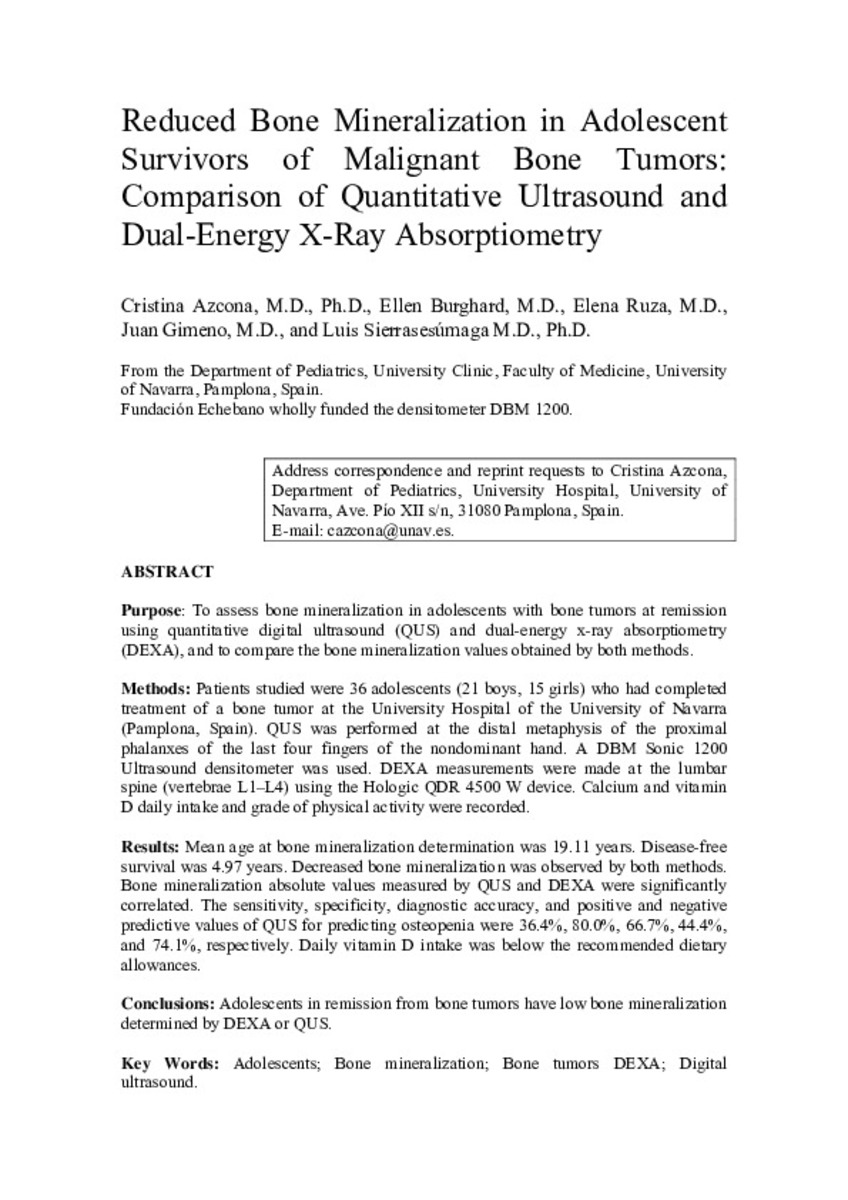Full metadata record
| DC Field | Value | Language |
|---|---|---|
| dc.creator | Azcona-San-Julian, M.C. (María Cristina) | - |
| dc.creator | Burghard, E. (Ellen) | - |
| dc.creator | Ruza, E. (Elena) | - |
| dc.creator | Gimeno, J. (Juan) | - |
| dc.creator | Sierrasesumaga, L. (Luis) | - |
| dc.date.accessioned | 2012-11-22T09:49:01Z | - |
| dc.date.available | 2012-11-22T09:49:01Z | - |
| dc.date.issued | 2003 | - |
| dc.identifier.citation | Azcona C, Burghard E, Ruza E, Gimeno J, Sierrasesúmaga L. Reduced bone mineralization in adolescent survivors of malignant bone tumors: comparison of quantitative ultrasound and dual-energy x-ray absorptiometry. J Pediatr Hematol Oncol. 2003 Apr;25(4):297-302. | es_ES |
| dc.identifier.issn | 1077-4114 | - |
| dc.identifier.uri | https://hdl.handle.net/10171/23763 | - |
| dc.description.abstract | To assess bone mineralization in adolescents with bone tumors at remission using quantitative digital ultrasound (QUS) and dual-energy x-ray absorptiometry (DEXA), and to compare the bone mineralization values obtained by both methods. METHODS: Patients studied were 36 adolescents (21 boys, 15 girls) who had completed treatment of a bone tumor at the University Hospital of the University of Navarra (Pamplona, Spain). QUS was performed at the distal metaphysis of the proximal phalanxes of the last four fingers of the nondominant hand. A DBM Sonic 1200 Ultrasound densitometer was used. DEXA measurements were made at the lumbar spine (vertebrae L1-L4) using the Hologic QDR 4500 W device. Calcium and vitamin D daily intake and grade of physical activity were recorded. RESULTS: Mean age at bone mineralization determination was 19.11 years. Disease-free survival was 4.97 years. Decreased bone mineralization was observed by both methods. Bone mineralization absolute values measured by QUS and DEXA were significantly correlated. The sensitivity, specificity, diagnostic accuracy, and positive and negative predictive values of QUS for predicting osteopenia were 36.4%, 80.0%, 66.7%, 44.4%, and 74.1%, respectively. Daily vitamin D intake was below the recommended dietary allowances. CONCLUSIONS: Adolescents in remission from bone tumors have low bone mineralization determined by DEXA or QUS. | es_ES |
| dc.language.iso | eng | es_ES |
| dc.publisher | Lippincott, Williams & Wilkins | es_ES |
| dc.rights | info:eu-repo/semantics/openAccess | es_ES |
| dc.subject | Lumbar Vertebrae/radiography | es_ES |
| dc.subject | Nutrition Disorders/complications | es_ES |
| dc.subject | Osteosarcoma/complications/drug therapy/radiotherapy/surgery | es_ES |
| dc.title | Reduced Bone Mineralization in Adolescent Survivors of Malignant Bone Tumors: Comparison of Quantitative Ultrasound and Dual-Energy X-Ray Absorptiometry | es_ES |
| dc.type | info:eu-repo/semantics/article | es_ES |
| dc.relation.publisherversion | http://journals.lww.com/jpho-online/Abstract/2003/04000/Reduced_Bone_Mineralization_in_Adolescent.6.aspx | es_ES |
| dc.type.driver | info:eu-repo/semantics/article | es_ES |
Files in This Item:
Statistics and impact
Items in Dadun are protected by copyright, with all rights reserved, unless otherwise indicated.






